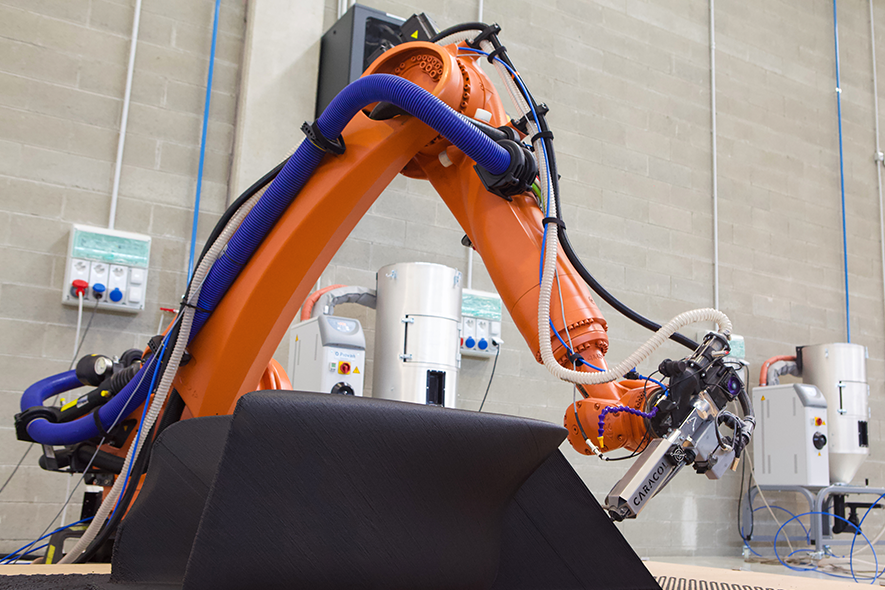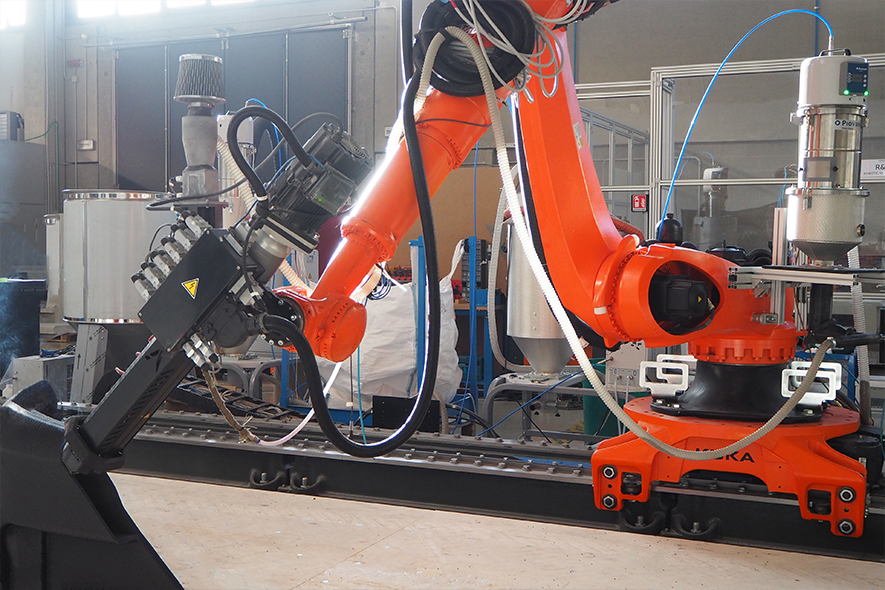
The past two years have seen a growing presence of robotics and large format solutions taking center stage in the AM industry. This “trend” seems to be set to stay as is shown by its healthy growth and industrial endorsement compared to other areas of the industry. But what has differentiated this segment?
First and foremost, while players are often smaller AM firms, startups and divisions of industrial machinery OEMs, the approach taken by leading companies has been to focus on nurturing market adoption with a strong go-to-market strategy based on applications, from the early days. These innovative machines, while integrating robotics and disruptive technologies, have been positioned more as manufacturing solutions for advanced sectors instead of spotlighting them mostly as radical innovations.

A company like Caracol built is foundations around this idea. The firm’s core product, Heron AM, was developed and perfected with clients in mind. Caracol created its integrated robotic large format 3D printing platform to expand the potential of additive manufacturing towards larger, complex, industrial applications. Understanding how such a radically new machine might need to be introduced in clients’ workflows with support and at a very mature stage, the company spent years 3D printing parts and components themselves alongside industry leaders, and still adopts this application-first approach as part of their DNA to drive technological innovation. This was especially important considering how there is no direct transferal of know-how from traditional 3D printing to LFAM, including aspects such as DfAM, constraints, materials behavior on large scale parts, and much more.
Overall, the aim Caracol has set for itself is to ensure clients’ production quality and continuity for the most advanced applications across sectors. It has been doing so by providing both a reliable technology, as well as an extensive set of services that help clients leverage the full potential of their machines – going far beyond traditional customer service in supporting the introduction to LFAM. This quickly translated itself into a successful strategy for Caracol, who since the market launch of its Heron machines at the end of 2022, has managed to garner trust of its users and see their equipment be installed globally in factories that meet the highest standards for production, industrial requirements, and quality criteria.

A second factor that has contributed to the steady growth of the LFAM segment is that players have been trying to work synergically: leveraging what everyone across the value chain can bring to the table and seeing how the growth of partners and competitors can help the overall market flourish.
With a strong value chain built by material producers, hardware and software developers, service bureaus, post-processing specialists or OEMs, and end-users – the market has quickly seen how LFAM solutions can deliver tangible parts and applications across sectors. For example, Solidtech – Portuguese service provider – has said how by collaborating with an OEM like Caracol, and sharing know-how, ideas, technical insights, and a continuous flow of data, they’ve managed to deliver some great results producing parts with LFAM for customers in industries ranging from automotive to design.

Experimenting together, opens the possibility of quickly bringing technological advancements to market, such as by delivering applications that are unseen today in the AM world, using new bio or sustainable materials, or leveraging robotics to go beyond geometric constraints with non-planar printing.
The sector is coming to terms with the idea that it is pivotal to understand how by working together, the AM value chain, can help customers achieve their manufacturing goals. It is possible therefore to generate value for all if the focus is shifted towards the client. Doing so has allowed the LFAM sector to grow and demonstrate that these technologies can be a solution to help reduce costs and increase efficiencies, simplify and automatize the process for clients and facilitate adoption, and ultimately ensure technology is a means to a tangible end.
To learn more about LFAM and robotics, join Francesco De Stefano, CEO and Co-founder of Caracol, together with other leading players in the large format segment for the panel “Automation & Robotic 3D printing” at Additive Manufacturing Strategies in New York on February 8th.
Subscribe to Our Email Newsletter
Stay up-to-date on all the latest news from the 3D printing industry and receive information and offers from third party vendors.
You May Also Like
Further Understanding of 3D Printing Design at ADDITIV Design World
ADDITIV is back once again! This time, the virtual platform for additive manufacturing will be holding the first-ever edition of ADDITIV Design World on May 23rd from 9:00 AM –...
3D Printer Maker EVO-tech Reborn as NEVO3D — Once More With Feeling
EVO-tech was a 3D printing service and original equipment manufacturer established in 2013 and based in Schörfling am Attersee, Austria. The company produced high-quality material extrusion systems featuring linear bearings,...
3D Systems Brings 3D Printed PEEK Cranial Implant to the U.S. with FDA Clearance
For more than 10 years, 3D Systems (NYSE:DDD) has worked hand-in-hand with surgeons to plan over 150,000 patient-specific cases, and develop more than two million instruments and implants from its...
CDFAM Returns to Berlin for Second Annual Symposium
The second CDFAM Computational Design Symposium is scheduled for May 7-8, 2024, in Berlin, and will convene leading experts in computational design across all scales. Building upon the first event...































